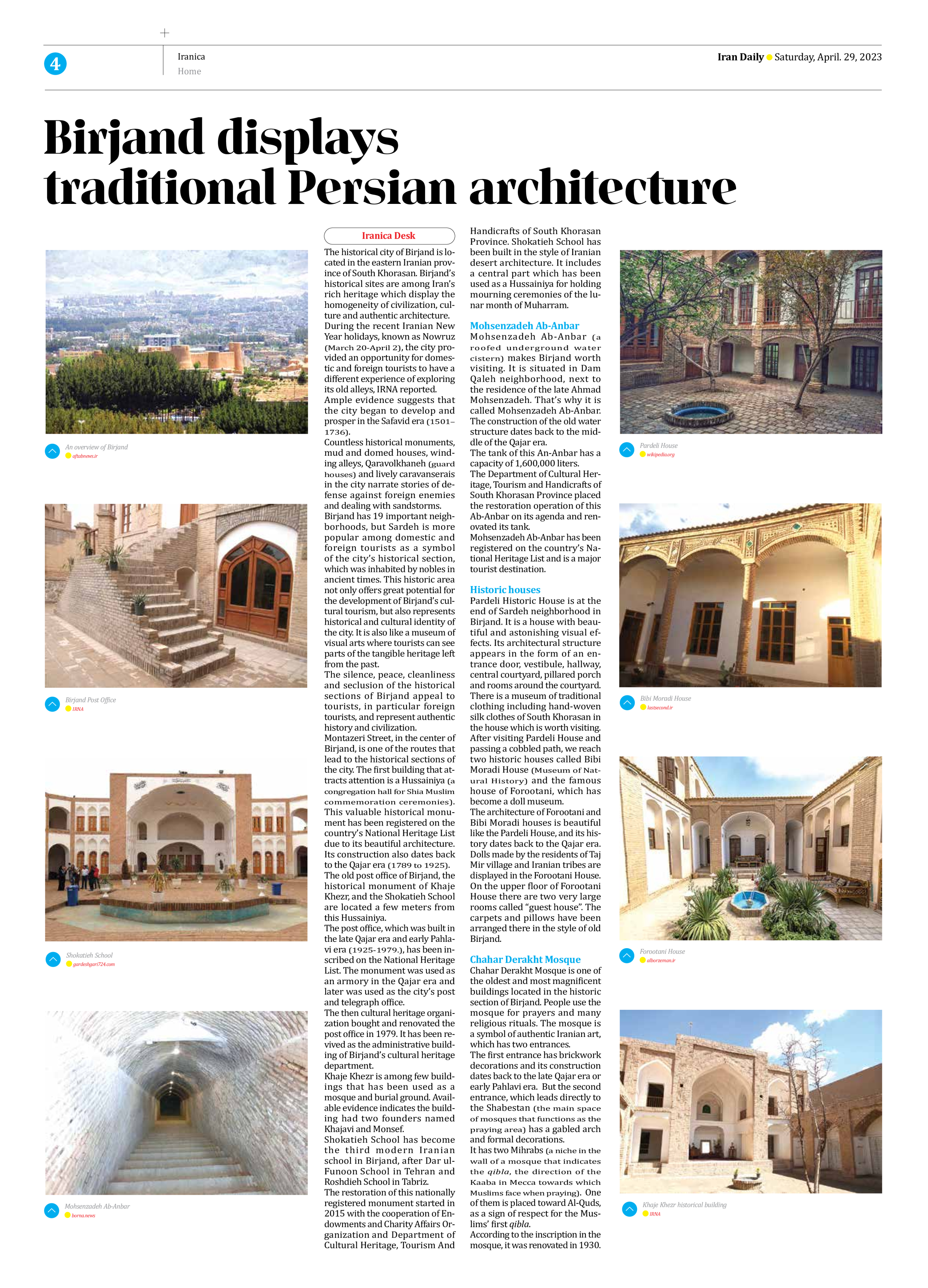
Birjand displays traditional Persian architecture
The historical city of Birjand is located in the eastern Iranian province of South Khorasan. Birjand’s historical sites are among Iran’s rich heritage which display the homogeneity of civilization, culture and authentic architecture.
During the recent Iranian New Year holidays, known as Nowruz (March 20-April 2), the city provided an opportunity for domestic and foreign tourists to have a different experience of exploring its old alleys, IRNA reported.
Ample evidence suggests that the city began to develop and prosper in the Safavid era (1501–1736).
Countless historical monuments, mud and domed houses, winding alleys, Qaravolkhaneh (guard houses) and lively caravanserais in the city narrate stories of defense against foreign enemies and dealing with sandstorms.
Birjand has 19 important neighborhoods, but Sardeh is more popular among domestic and foreign tourists as a symbol of the city’s historical section, which was inhabited by nobles in ancient times. This historic area not only offers great potential for the development of Birjand’s cultural tourism, but also represents historical and cultural identity of the city. It is also like a museum of visual arts where tourists can see parts of the tangible heritage left from the past.
The silence, peace, cleanliness and seclusion of the historical sections of Birjand appeal to tourists, in particular foreign tourists, and represent authentic history and civilization.
Montazeri Street, in the center of Birjand, is one of the routes that lead to the historical sections of the city. The first building that attracts attention is a Hussainiya (a congregation hall for Shia Muslim commemoration ceremonies). This valuable historical monument has been registered on the country’s National Heritage List due to its beautiful architecture. Its construction also dates back to the Qajar era (1789 to 1925).
The old post office of Birjand, the historical monument of Khaje Khezr, and the Shokatieh School are located a few meters from this Hussainiya.
The post office, which was built in the late Qajar era and early Pahlavi era (1925-1979.), has been inscribed on the National Heritage List. The monument was used as an armory in the Qajar era and later was used as the city’s post and telegraph office.
The then cultural heritage organization bought and renovated the post office in 1979. It has been revived as the administrative building of Birjand’s cultural heritage department.
Khaje Khezr is among few buildings that has been used as a mosque and burial ground. Available evidence indicates the building had two founders named Khajavi and Monsef.
Shokatieh School has become the third modern Iranian school in Birjand, after Dar ul-Funoon School in Tehran and Roshdieh School in Tabriz.
The restoration of this nationally registered monument started in 2015 with the cooperation of Endowments and Charity Affairs Organization and Department of Cultural Heritage, Tourism And Handicrafts of South Khorasan Province. Shokatieh School has been built in the style of Iranian desert architecture. It includes a central part which has been used as a Hussainiya for holding mourning ceremonies of the lunar month of Muharram.
Mohsenzadeh Ab-Anbar
Mohsenzadeh Ab-Anbar (a roofed underground water cistern) makes Birjand worth visiting. It is situated in Dam Qaleh neighborhood, next to the residence of the late Ahmad Mohsenzadeh. That’s why it is called Mohsenzadeh Ab-Anbar. The construction of the old water structure dates back to the middle of the Qajar era.
The tank of this An-Anbar has a capacity of 1,600,000 liters.
The Department of Cultural Heritage, Tourism and Handicrafts of South Khorasan Province placed the restoration operation of this Ab-Anbar on its agenda and renovated its tank.
Mohsenzadeh Ab-Anbar has been registered on the country’s National Heritage List and is a major tourist destination.
Historic houses
Pardeli Historic House is at the end of Sardeh neighborhood in Birjand. It is a house with beautiful and astonishing visual effects. Its architectural structure appears in the form of an entrance door, vestibule, hallway, central courtyard, pillared porch and rooms around the courtyard. There is a museum of traditional clothing including hand-woven silk clothes of South Khorasan in the house which is worth visiting.
After visiting Pardeli House and passing a cobbled path, we reach two historic houses called Bibi Moradi House (Museum of Natural History) and the famous house of Forootani, which has become a doll museum.
The architecture of Forootani and Bibi Moradi houses is beautiful like the Pardeli House, and its history dates back to the Qajar era. Dolls made by the residents of Taj Mir village and Iranian tribes are displayed in the Forootani House.
On the upper floor of Forootani House there are two very large rooms called “guest house”. The carpets and pillows have been arranged there in the style of old Birjand.
Chahar Derakht Mosque
Chahar Derakht Mosque is one of the oldest and most magnificent buildings located in the historic section of Birjand. People use the mosque for prayers and many religious rituals. The mosque is a symbol of authentic Iranian art, which has two entrances.
The first entrance has brickwork decorations and its construction dates back to the late Qajar era or early Pahlavi era. But the second entrance, which leads directly to the Shabestan (the main space of mosques that functions as the praying area) has a gabled arch and formal decorations.
It has two Mihrabs (a niche in the wall of a mosque that indicates the qibla, the direction of the Kaaba in Mecca towards which Muslims face when praying). One of them is placed toward Al-Quds, as a sign of respect for the Muslims’ first qibla.
According to the inscription in the mosque, it was renovated in 1930.







